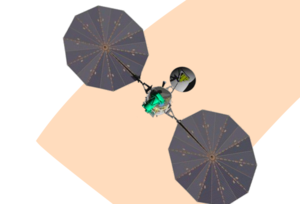Mars 2022 orbiter

The Mars 2022 telecomm orbiter concept features ion thrusters and improved solar arrays
|
|||||
| Names | Next Mars Orbiter (NeMO) | ||||
|---|---|---|---|---|---|
| Mission type | Telecommunications and reconnaissance | ||||
| Operator | NASA | ||||
| Mission duration | Planned: 6.5 years | ||||
| Spacecraft properties | |||||
| Launch mass | 1,900 kg (4,200 lb) | ||||
| Dry mass | 1,300 kg (2,900 lb) | ||||
| Payload mass | Instruments: 50 kg (110 lb) | ||||
| Power | 20 kW solar arrays | ||||
| Start of mission | |||||
| Launch date | Proposed: July 2022 | ||||
| Rocket | Falcon 9 or Atlas V-411 | ||||
| Mars orbiter | |||||
| Orbital insertion | September 2023 | ||||
| Orbit parameters | |||||
| Periareion | 320 km (200 mi) | ||||
| Inclination | 75°–93° (polar orbit) | ||||
|
|||||
The Mars 2022 orbiter (Next Mars Orbiter, or NeMO) is a proposed NASA Mars communications satellite with high-resolution imaging payload and two solar-electric ion thrusters.
The orbiter is proposed to be launched in September 2022 to link ground controllers with rovers and landers and extend mapping capabilities expected to be lost when the Mars Reconnaissance Orbiter and 2001 Mars Odyssey stop functioning.
Key features under study include solar electric ion drive engines, better solar arrays, and broadband laser communications (optic communication) between Earth and Mars.
The orbiter is conceptually similar to the Mars Telecommunications Orbiter, canceled in 2005, and could be a technology precursor for a future round-trip sample return mission and human expeditions to Mars. Robert Lock is leading the concept studies for the 2022 orbiter.
Concern in NASA is that the currently used relay satellites, 2001 Mars Odyssey and Mars Reconnaissance Orbiter, may stop functioning, resulting in the need to press the MAVEN science orbiter into use as a backup telecommunications relay. However, the highly elliptical orbit of MAVEN will limit its usefulness as a relay for surface operations.
Another suggested feature under study is "the sample rendezvous capture and return capability." The samples cached by the Mars 2020 rover would be placed in Mars orbit by a future Mars ascent vehicle. From there the orbiter would send the samples back to Earth.
The proposed orbiter would be propelled with two solar-electric ion thrusters; one engine would be active while the other one would be a spare. Electrical power to the engines would be provided by advanced solar arrays that generate 20 kW.
An ion engine would give the spacecraft significant orbital flexibility for long-term support of future missions, opportunistic flybys of Phobos and Deimos, as well as the added capability of orbit support—rendezvous and capture—for a sample return mission. An ion engine would also allow access to multiple latitudes and altitudes to optimize relay contacts.
...
Wikipedia
